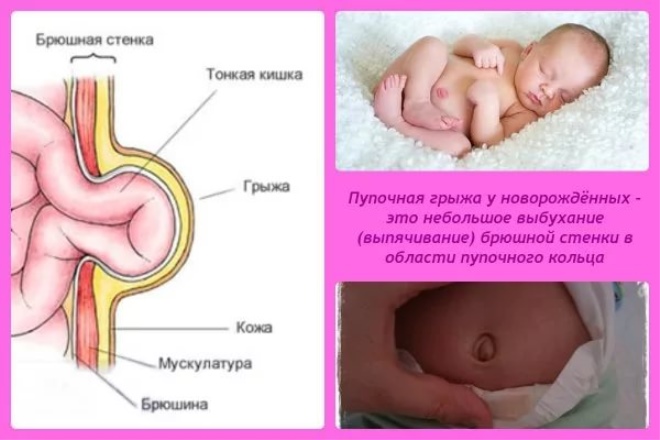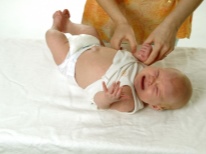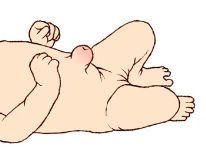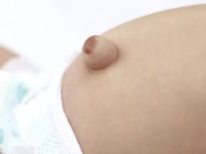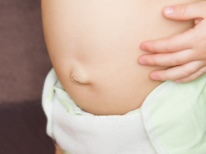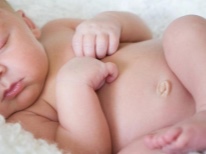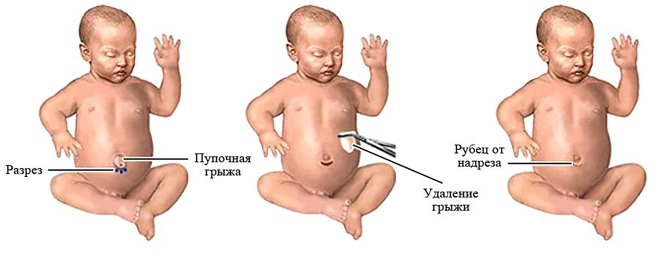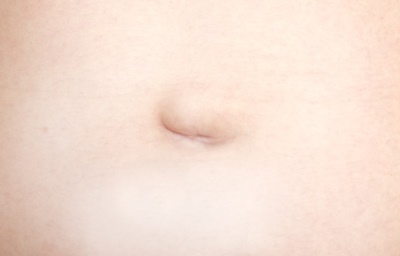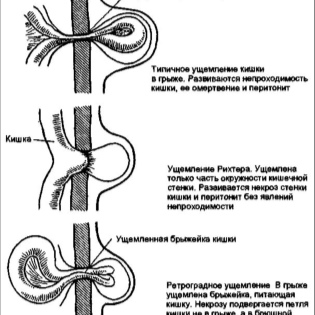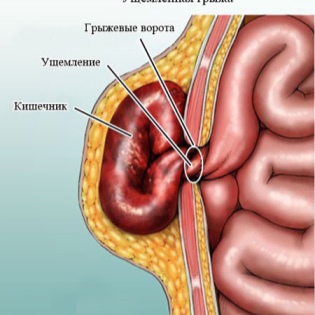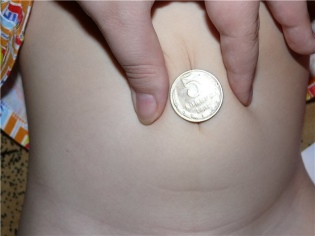What does an umbilical hernia look like in children?
The navel of babies is a subject of special care and anxiety of parents. It requires special care after discharge from the hospital, careful observation by mom and dad, because to “overlook” the occurrence umbilical hernia self-respecting parents can not afford. If you want to know what the umbilical hernia looks like in children, read this article.
Where is she located?
The umbilical hernia (if any) is not always located directly inside the baby's navel. Sometimes the hernial sac may protrude in the umbilical region — above or below the place where the umbilical wound was located after the maternity hospital. In any case, you should not look for pathology where it does not exist (on the entire surface of the abdomen). Because always the exit of the hernial bag is carried out exclusively through the umbilical ring.
Searches should begin where there was a place of attachment of the umbilical cord during pregnancy. After cutting off the umbilical cord, not all babies have a ring that is tightened with connective tissue for 30 days set by medicine. As a result, a certain convex formation is usually formed on this place.
How she looks like?
Hernia in young children, it is a ball-shaped formation or has a slightly irregular shape. In one part it has a larger volume than in the other. Most often sizes hernia in newborns and children under 1 year small - from 0.5 to 3.5 centimeters in diameter. Less commonly, a hernia can reach up to 5 centimeters in diameter.
Then it all depends on what the contents of the hernial sac are actually. If intestinal loops are caught in it, the hernia in a tense state will have a slightly grayish, bluish color; through the thin children's skin, the intestinal wall can be easily viewed.
If there is a part of another internal organ in the sac, the hernia will be more reddish or white. Around the "ball" may be one or more skin folds - depending on the size of the bag.
Symptoms and diagnosis
Children's umbilical hernia is not always noticeable. You can pay attention to the protruding ball when the child cries a lot, screams, strains before emptying the bowels or coughing. With all these actions in the supine position, the muscles of the abdominal wall tense strongly. With their tonus, the hernial sac slips freely through the umbilical ring, which is not able to contain it due to its weakness or slow overgrowing.
If at this moment lightly press the “ball” with the pad of your finger, it will freely go back into the abdominal cavity and remain on the other side of the umbilical ring until the next cry or cough.
Parents should not think that such a hernia hurts a child. No, she does not bother him at all, does not affect the pace of its development.
Some experts attribute a truly destructive impact to a baby umbilical hernia - it does not sleep, and causes constant crying and moods, and disrupts digestion. Unreduced hernia does not do anything like this, therefore it is not quite correct to consider a bad dream or useless kid's appetite as a result of a hernia.
If there is a pinching of the hernia (the hernial sac is suddenly clamped by the umbilical ring), then there is not much to look for the symptoms. This condition is always associated with severe and sudden pain. The child will scream, keep the legs pressed to the stomach, without straightening them. Vomiting may occur.
The hernia itself at this moment will look “bloated”, very tense, bluish, as if it is ready to burst. When lightly pressed with a finger, the hernial sac will not go inside, as he always did, and the pain will intensify.
How to determine a relapse?
Most of the uncorrected, uncomplicated umbilical hernia in children passes on their own - as they grow. If by the age of five the child continues to have the umbilical ring open, then the decision is made to conduct a surgical operation.
Earlier than this age, a child can be operated on only if a hernia is strangulated. The intervention is carried out with gentle modern methods, using a laser, so there are no scars or scary scarring after such a manipulation by surgeons on the body of the child.
The navel, of course, after the operation will not look round and smooth, but worth it. Surgery to remove or reduce the umbilical hernia (even the last very successfully) does not guarantee, however, that the child will not have a relapse - the reappearance of the hernia.
This is what a relapse after surgery looks like. Hernia appears slightly higher or slightly sideways from the operated umbilical ring.
What to do when detected?
If a navel hernia is detected (even if there is no absolute certainty that it is she), you must show the child to the pediatric surgeon. He will be able to dispel doubts by ordering additional studies - an abdominal ultrasound scan and an X-ray examination of the abdominal organs.
This will help establish the exact size, location of the hernia, as well as the contents of the hernial sac. It can be intestinal loops, and glands, and parts of the bladder, as well as the liver. It is extremely important for the surgeon to make a decision on treatment, to learn about the possible risks of injury.
What not to do:
- It is categorically impossible to self-correct a hernia and seal it with a plaster or to attach a five-ruble coin to it. The decision on the reduction takes only a doctor and he does it himself, if he considers it appropriate.
- You can not try to right a hernia, if the child had a pinch. Such a child needs urgent hospitalization in an emergency room in a surgical hospital, in an emergency operation. Missed time can lead to necrosis of the tissues of internal organs, clamped in the hernial sac. No blood will flow to them, even gangrene is possible.
In this issue of Dr. Komarovsky, one of the topics covered is precisely the case of an umbilical hernia.


